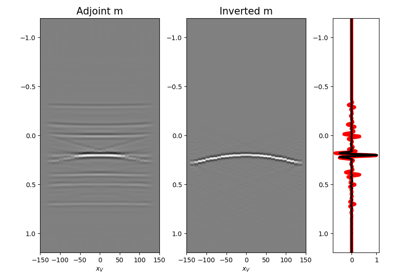pylops.waveeqprocessing.MDD¶
-
pylops.waveeqprocessing.MDD(G, d, dt=0.004, dr=1.0, nfmax=None, wav=None, twosided=True, causality_precond=False, adjoint=False, psf=False, dtype='float64', dottest=False, saveGt=True, add_negative=True, **kwargs_lsqr)[source]¶ Multi-dimensional deconvolution.
Solve multi-dimensional deconvolution problem using
scipy.sparse.linalg.lsqriterative solver.Parameters: - G :
numpy.ndarray Multi-dimensional convolution kernel in time domain of size \([n_s \times n_r \times n_t]\) for
twosided=Falseortwosided=Trueandadd_negative=True(with only positive times) or size \([n_s \times n_r \times 2*n_t-1]\) fortwosided=Trueandadd_negative=False(with both positive and negative times)- d :
numpy.ndarray Data in time domain \([n_s (\times n_vs) \times n_t]\)
- dt :
float, optional Sampling of time integration axis
- dr :
float, optional Sampling of receiver integration axis
- nfmax :
int, optional Index of max frequency to include in deconvolution process
- wav :
numpy.ndarray, optional Wavelet to convolve to the inverted model and psf. If
None, the outputs of the inversion are returned directly- twosided :
bool, optional MDC operator and data both negative and positive time (
True) or only positive (False)- add_negative :
bool, optional Add negative side to MDC operator and data (
True) or not (False)- operator and data are already provided with both positive and negative sides. To be used only withtwosided=True.- causality_precond :
bool, optional Apply causality mask (
True) or not (False)- adjoint :
bool, optional Compute and return adjoint(s)
- psf :
bool, optional Compute and return Point Spread Function (PSF) and its inverse
- dtype :
bool, optional Type of elements in input array.
- dottest :
bool, optional Apply dot-test
- saveGt :
bool, optional Save
GandG^Hto speed up the computation of adjoint ofpylops.signalprocessing.Fredholm1(True) or createG^Hon-the-fly (False) Note thatsaveGt=Truewill be faster but double the amount of required memory- **kwargs_lsqr
Arbitrary keyword arguments for
scipy.sparse.linalg.lsqrsolver
Returns: - minv :
numpy.ndarray Inverted model of size \([n_r (\times n_{vs}) \times n_t]\) for
twosided=Falseor \([n_r (\times n_vs) \times 2*n_t-1]\) fortwosided=True- madj :
numpy.ndarray Adjoint model of size \([n_r (\times n_{vs}) \times n_t]\) for
twosided=Falseor \([n_r (\times n_r) \times 2*n_t-1]\) fortwosided=True- psfinv :
numpy.ndarray Inverted psf of size \([n_r \times n_r \times n_t]\) for
twosided=Falseor \([n_r \times n_r \times 2*n_t-1]\) fortwosided=True- psfadj :
numpy.ndarray Adjoint psf of size \([n_r \times n_r \times n_t]\) for
twosided=Falseor \([n_r \times n_r \times 2*n_t-1]\) fortwosided=True
See also
MDC- Multi-dimensional convolution
Notes
Multi-dimensional deconvolution (MDD) is a mathematical ill-solved problem, well-known in the image processing and geophysical community [1].
MDD aims at removing the effects of a Multi-dimensional Convolution (MDC) kernel or the so-called blurring operator or point-spread function (PSF) from a given data. It can be written as
\[\mathbf{d}= \mathbf{D} \mathbf{m}\]or, equivalently, by means of its normal equation
\[\mathbf{m}= (\mathbf{D}^H\mathbf{D})^{-1} \mathbf{D}^H\mathbf{d}\]where \(\mathbf{D}^H\mathbf{D}\) is the PSF.
[1] Wapenaar, K., van der Neut, J., Ruigrok, E., Draganov, D., Hunziker, J., Slob, E., Thorbecke, J., and Snieder, R., “Seismic interferometry by crosscorrelation and by multi-dimensional deconvolution: a systematic comparison”, Geophyscial Journal International, vol. 185, pp. 1335-1364. 2011. - G :
